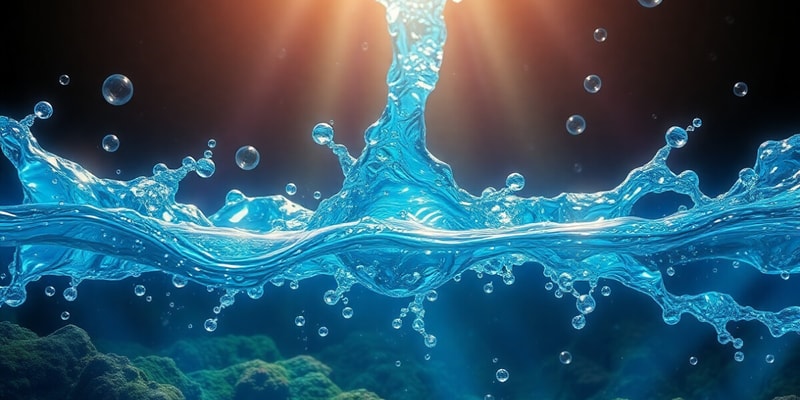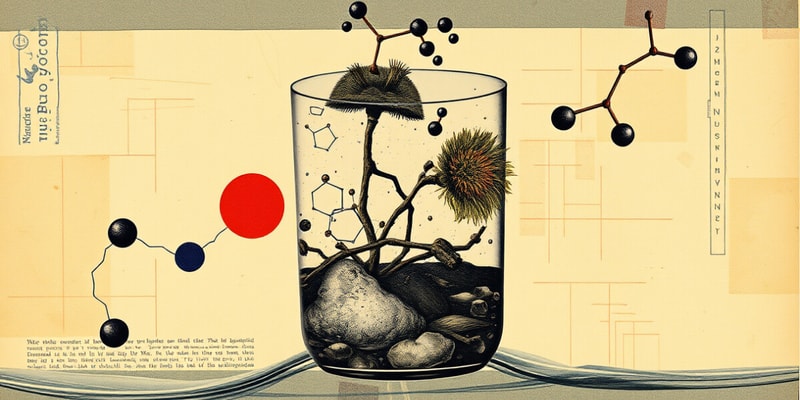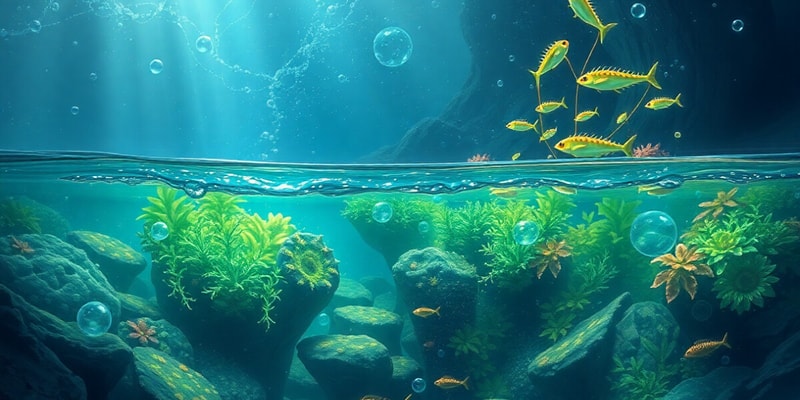Podcast Beta
Questions and Answers
What factor is primarily responsible for water's ability to serve as both a hydrogen bond donor and acceptor?
What is the main reason that ice floats on liquid water?
At what temperature is water at its maximum density?
How many other water molecules, on average, is a single water molecule associated with at 25 °C?
Signup and view all the answers
Which of the following properties is unique to water compared to other common solvents listed?
Signup and view all the answers
What is the geometry of a water molecule?
Signup and view all the answers
What is the term used to describe the energy required to overcome attractive forces between molecules in the liquid phase?
Signup and view all the answers
What accounts for water's high specific heat capacity?
Signup and view all the answers
Which property of water is responsible for ice floating?
Signup and view all the answers
Why do polar biomolecules tend to be soluble in water?
Signup and view all the answers
What is a direct consequence of water's high heat of vaporization?
Signup and view all the answers
What role do electronegative elements play in the formation of hydrogen bonds?
Signup and view all the answers
What phenomenon do hydrophobic effects contribute to in biological systems?
Signup and view all the answers
Which of the following statements regarding hydrogen bonds is true?
Signup and view all the answers
What is the relationship between pH and pOH in an aqueous solution?
Signup and view all the answers
How does a change of 1 unit in pH affect the hydrogen ion concentration?
Signup and view all the answers
If the dissociation constant Ka of acetic acid is 1.74×10-5 M, what does this indicate about its strength as an acid?
Signup and view all the answers
What equation is used to calculate pH from the hydrogen ion concentration [H+]?
Signup and view all the answers
In a neutral solution at 25°C, what are the concentrations of hydrogen ions and hydroxide ions?
Signup and view all the answers
Using the Henderson–Hasselbalch equation, what does pH equal when given Ka and the concentrations of HA and A-?
Signup and view all the answers
What happens to osmotic pressure when more biomolecules are added to a solution?
Signup and view all the answers
What is one reason why isotonic saline solutions are used for patient hydration instead of pure water?
Signup and view all the answers
Which of the following is a non-colligative property of water?
Signup and view all the answers
How does osmotic pressure behave in relation to the molecular weight of solutes?
Signup and view all the answers
When glucose is added to water, how does its behavior compare to that of ethanol?
Signup and view all the answers
What is the primary driving factor for osmosis?
Signup and view all the answers
Which of the following statements about osmotic burst is correct?
Signup and view all the answers
Which factor is NOT considered a colligative property of solutions?
Signup and view all the answers
What effect does a synthetic large biopolymer have in a cell's osmotic pressure?
Signup and view all the answers
The main consequence of high osmotic pressure in the cytoplasm is:
Signup and view all the answers
Study Notes
Water - The Solvent of Life
- Water is the most abundant substance in living organisms, making up about 70% of their weight.
- Water is essential for the existence of life on Earth, shaping the evolution of life on our planet.
- Crucial biological processes occur due to attractive forces between water molecules. These include hydrogen bonding, dipole-dipole interactions, and the ability of water to dissolve and associate ions through ion-dipole interactions.
Water Structure
- Water follows the octet rule with four electron pairs surrounding an oxygen atom.
- These electrons are in four sp3 orbitals, with two of these pairs forming covalent bonds with two hydrogen atoms.
- The remaining pairs are nonbonding lone pairs.
- The molecule has a distorted tetrahedral geometry.
- The electronegativity of the oxygen atom creates a net dipole moment, allowing water to act both as a hydrogen bond donor and acceptor.
H-Bonding in Water
- Hydrogen bonds hold water molecules together in both solid (ice) and liquid states.
- Ice has a hexagonal crystal structure due to its many hydrogen bonds.
- The regular lattice structure of ice results in lower entropy and density compared to liquid water.
- Ice floats because of its lower density than liquid water.
- Upon melting, some hydrogen bonds break, increasing the density of water. This explains the maximum density of water at 4°C.
- Liquid water has a dynamic structure where hydrogen bonds constantly form and break, forming flickering clusters of water molecules.
Important Properties of Water
- Water has polar covalent bonds, leading to high polarity.
- High polarity: Water's ability to form hydrogen bonds allows it to dissolve ions and polar molecules.
- High specific heat capacity: Water acts as a thermal insulator.
- High heat of vaporization: Sweating helps cool the body.
- High dielectric constant: Water acts as an electrical insulator due to charge separation within the molecules.
- Maximum density at 4°C: Ice floats on water.
- Hydrophobic effects: The interactions of nonpolar molecules with water lead to the formation of structures like micelles and lipid bilayers. This also plays a role in protein folding and enzyme-substrate interactions.
- Colligative Properties: These properties of a solution depend only on the concentration of solute particles and not their specific nature.
Interactions Between Water and Solutes
- Water molecules form hydrogen bonds with polar molecules containing electronegative elements like fluorine, nitrogen, and oxygen.
- Hydrogen bonds are strongest when involved molecules are aligned for maximum electrostatic interaction.
Polarity of Biomolecules
- Biomolecules containing oxygen and nitrogen functional groups are polar and can interact with water through hydrogen bonding and dipole-dipole interactions. These molecules are considered hydrophilic (water-loving) and dissolve in water.
- Non-polar molecules are hydrophobic (water-repelling) and do not readily dissolve in water.
Effects of Solutes on Water Properties
- Colligative properties of water are affected by the concentration of solute particles, including boiling point elevation, freezing point depression, osmotic pressure, and vapor pressure lowering.
- Osmotic pressure is driven by the movement of water from a region of high water concentration to a region of low water concentration. This pressure is a measure of the force required to prevent osmosis from occurring.
- Osmosis refers to the movement of water through a semipermeable membrane driven by differences in osmotic pressure or water concentration.
pH and Buffer Systems
- pH measures hydrogen ion concentration in a solution, with lower pH indicating higher acidity.
- pOH is the negative logarithm of hydroxide ion concentration.
- The Henderson-Hasselbalch equation relates pH, pKa (acid dissociation constant), and the ratio of an acid and its conjugate base.
- Buffers are solutions that resist pH changes, typically composed of a weak acid and its conjugate base.
- The buffering capacity of a system is greatest when the pH is close to the pKa.
- Intracellular buffers, including phosphate buffers and protein buffers, help maintain a constant pH within cells.
Dissociation of Weak Acids
- Weak acids only partially dissociate in water, with their extent of dissociation denoted by Ka, the acid dissociation constant.
- Calculating the pH of a solution with a weak acid requires considering the equilibrium of the ionization reaction.
Studying That Suits You
Use AI to generate personalized quizzes and flashcards to suit your learning preferences.
Related Documents
Description
Explore the essential role of water in life and its unique molecular structure. Understand how its properties, including hydrogen bonding and polarity, facilitate crucial biological processes. This quiz delves into water's significance as a solvent and its impact on the evolution of life.




